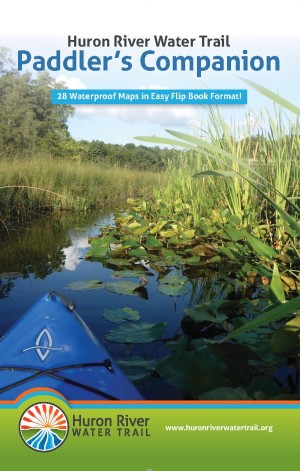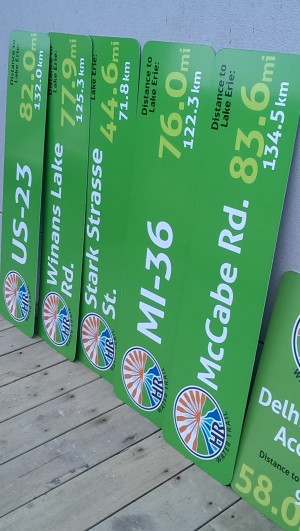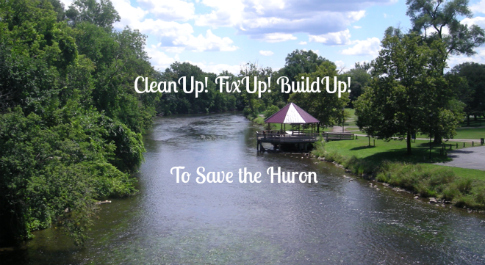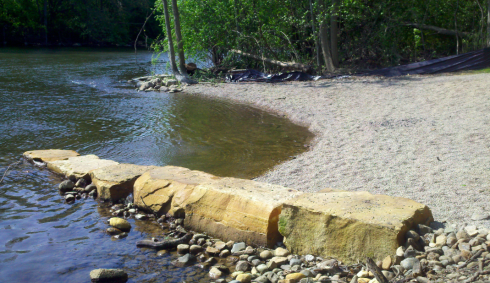I had the good fortune not too long ago to have coffee with Huron River Watershed Council (HRWC) Executive Director Laura Rubin. While we didn’t have great deal of time to discuss the condition of the Huron River, as we’d met to discuss something else, Laura did mention that their RiverUp! campaign was making great strides, and suggested that I reach out to HRWC Deputy Director Elizabeth Riggs, who is responsible for the initiative. Well, it took me a while, but I finally found the time to do just that. And what follows is my conversation with Elizabeth Riggs. I hope you find it as awesome and encouraging as I did.
MARK: For those in the audience who may not know the history, what was the impetus behind the RiverUp! campaign?
ELIZABETH: A few years ago, the “Dean” of the House of Representatives, John Dingell, was celebrating the creation of the Detroit International Wildlife Refuge with leaders from business and environmental organizations, when he challenged them to leave a legacy on the Huron River. They accepted his challenge in earnest and worked to create RiverUp!.
MARK: So RiverUp! is bigger than just the HRWC…
ELIZABETH: Yes, RiverUp! is a private-public partnership, which presents a unique opportunity to leverage the strengths and resources of numerous groups, including HRWC.
MARK: What were the objectives of the campaign at the outset? And how, if at all, have they evolved since the initial launch?
ELIZABETH: We call RiverUp! a ‘renaissance’ for the river. The objectives of the campaign reflect this idea of re-birth by focusing resources and energy on 1) improving river health, 2) improving river recreation access and experience, and 3) transforming the river corridor into a destination with vibrant Trail Towns linked by the Huron River Water Trail and greenways. We refer to these three objectives as… CleanUp!, FixUp!, and BuildUp!.
Of the three objectives, BuildUp! has evolved the most as we’ve pursued the Trail Towns concept for the five largest communities on the river — Milford, Dexter, Ann Arbor, Ypsilanti, and Flat Rock. Trail Towns turns out to be a terrific process for building local public-private teams that envision what their town offers for trail users, then develop strategies that are implemented to incorporate river- and trail-based recreation into community development and promotion. Each community drives their own process, but RiverUp! provides a Trails Towns coordinator to assist their efforts.
MARK: It’s always seemed odd to me that we haven’t done more as a community to activate the riverfront. While we certainly have great public parks along the Huron, it’s never made sense to me that we haven’t seen more in the way of riverfront development. Why is it, in your opinion, that we haven’t seen that happen? Is it felt that the Huron isn’t big enough to support that kind of development? Is it a matter of zoning? Is it owners that feel development would negatively impact the natural beauty of the river?
 ELIZABETH: I’ve wondered that myself, especially since the river is in rather good shape and is popular for recreation of all kinds. In most of the riverfront communities, activities along the river were heavy, polluting industries, railroads, and energy substations. It’s taken a while to clean up these sites and the water quality. And then it takes time to convince people and businesses that the river is clean and beautiful.
ELIZABETH: I’ve wondered that myself, especially since the river is in rather good shape and is popular for recreation of all kinds. In most of the riverfront communities, activities along the river were heavy, polluting industries, railroads, and energy substations. It’s taken a while to clean up these sites and the water quality. And then it takes time to convince people and businesses that the river is clean and beautiful.
Where the river is further from town, like in Ann Arbor, I’d suggest that there are two main reasons that the riverfront hasn’t been activated more. First, the river doesn’t flow through downtown as it does in the other Huron River communities, like Milford and Ypsilanti, so restaurants, shops, and public spaces are located about a 20-minute walk from the river. And, second, only recently has the conversation been elevated about making the river a new “Main Street” through the Blue Economy lens by groups such as the Michigan Economic Council’s Prima Civitas and by RiverUp!… Ann Arbor has been Tree Town, not so much River Town. But I see that changing, especially with potential for a new and better connection between the water and the community at the Broadway property (DTE Energy’s clean-up site), and the North Main corridor recommendations that came out of the task force last year.
MARK: For those who may not be familiar, what’s the current state of the Broadway site, and how are we likely to see it develop over the next several years?
ELIZABETH: DTE Energy is pursuing a plan for mixed-use development on the buildable part of the property closer to Broadway and the train station. There’s still considerable clean-up required, but the intent is to include a park and/or a walking and biking trail along the river.
MARK: You mentioned why it is that you think riverside development hasn’t happened in Ann Arbor. Have you given any thought as to why it hasn’t happened in Ypsilanti?
ELIZABETH: Thanks to those early planners for Ypsilanti, the city has a terrific riverfront. No doubt, you know that the Olmsted Brothers’ firm, affiliated with Frederick Law Olmsted, was commissioned to design the parks system along the river. They thoughtfully laid out the parks in a pattern reminiscent of jewels hanging from a necklace. On the higher ground, then, are the commercial and residential areas of Depot Town, Downtown, and such. Ypsilanti is in the process of changing its orientation to the river with the Border-to-Border Trail linkages, the future community recreation center on Water Street, Huron River Water Trail investments at the dam portage and access points, and so on. I’d love to see more places be oriented toward the river, like a restaurant facing the river that’s accessible by canoe or kayak.
MARK: Clearly it’s in the best interest of the Huron Watershed Council to have people actively engaging with the river at a substantive level. The more people appreciate the Huron, the more they’re likely to be good stewards of it, right? So that means increasing these opportunities for meaningful interaction. More fishing. More riverside entertainment. More thoughtful, Huron-facing development. More businesses that bring people to the river… One of the companies already doing that is Ypsilanti’s Schultz Outfitters. What is about our Depot Town fly fishing shop that resonates with you? And what does their success tell you about the potential of the Huron River?
ELIZABETH: Schultzy’s fly shop and guide business in Depot Town is just a perfect example of the type of river-related ventures that spark a river renaissance for the Huron and its communities. A healthy river is critical for a healthy bottom line. Not only does the shop bring visitors and dollars into Ypsilanti, and get people in the water, it also expands the community of river stewards caring for the river and protecting the resource. Our work in Ypsilanti, and other riverfront communities, is helping to identify existing river-related businesses that can increase their interaction with the river and bring in more customers, as well as entrepreneurial opportunities where gaps in service are identified. In Milford, the new River’s Edge Brewery is interested in making their riverfront property more attractive and more accessible to paddlers. In Flat Rock, a canoe and kayak outfitter business is expanding to provide livery services for the first time on the Downriver trip from the city to Lake Erie.
 MARK: How would you characterize the current health of the Huron River? Is it clean? Is there any sign that native species, at long last, are beginning to making inroads against the invasives?
MARK: How would you characterize the current health of the Huron River? Is it clean? Is there any sign that native species, at long last, are beginning to making inroads against the invasives?
ELIZABETH: The Huron River is the cleanest urban river in the Lower Peninsula thanks to extensive natural protected areas in its watershed, and to efforts of municipalities to reduce pollutants under federal Clean Water Act requirements. RiverUp!’s goal of a vibrant, robust, and restored river is based on the fact that the river is fishable, swimmable, and drinkable, and THAT is worth celebrating. But urban rivers have challenges. The Huron’s health is threatened by stormwater pollution, regulated river flows, and extreme weather events brought about by climate change. Mitigating and reducing populations of aquatic invasive species, plant and animal, is another challenge.
MARK: You mention swimming. I know that people jump out of their canoes in deeper parts of the river and such, but I’m not aware of any areas where swimming is explicitly allowed, let alone encouraged. Are there such areas? And, if not, might we expect to see such areas in the future?
ELIZABETH: Swimming (or “total body contact recreation” as the Clean Water Act calls it) is one of several rights to waters of the state enjoyed by the public. All lakes, rivers, ponds, and wetlands are designated and protected for all of the following uses: agriculture; navigation; industrial water supply; warmwater fishery; other indigenous aquatic life and wildlife; partial body contact recreation (i.e. fishing, water sports); and fish consumption. The river and its lakes and impoundments are designated and protected for total body contact recreation (i.e. swimming) from May 1 to October 1. Still, it’s a good idea to check ahead of time whether a specific area has posted warnings or restrictions; for example, Geddes Pond, behind the Dixboro Dam, posts warnings about the bacteria E. coli when weather and water conditions require it.
MARK: What can we do to make things better for our native species? Are there, for instance, examples of other rivers in the U.S. that have been able to eliminate invasive species? And, if so, how’d they do it?
ELIZABETH: It’s important to know how to identify and prevent invasive species from spreading. Invasive species are not native to the region and flourish without a natural predator or other means of natural balance. These invasive species spread quickly and exhaust resources used by native species, crowding them out. Most commonly found species in the watershed are the plants purple loosestrife, phragmites, and Eurasian milfoil, and the animals zebra mussel and Asiatic clam. In a region like Southeast Michigan, with its many lakes and streams, there are lots of opportunities for aquatic invasives to spread. Proper lake and stream management as well as maintenance of boating equipment can help. HRWC has good resources on its website to help people identify invasive plants and animals and actions to stop their spread.
MARK: I’m curious to know your thoughts on carp. It seems to me, at least in Ypsi, that they far outnumber other species, and I’m wondering what, if anything, can be done about that. Have things been attempted to better diversify the local ecosystem?
ELIZABETH: We’re just starting a multi-year project to restore the fisheries in a section of the river in Ypsilanti that will diversify the habitat and, as a result, diversify the species. River monitoring data collected by our staff and citizen scientists showed that the habitat was homogenous and few fish species were able to use the section. Our ecologist Paul Steen is working with ECT, Inc. to develop the plan for the restoration, and reaching out to engage the community as the project advances.
[above: Superior dam portage launch: The portage of the Superior Dam by St. Joseph Mercy is one of the Water Trail spots improved through RiverUp!.]
MARK: Assuming you had the funding and public support, what would you like to see done relative to the Huron River Watershed? Would you like, for instance, to see the remaining dams removed? Would you like to see the University of Michigan, perhaps, turn over some of their riverfront property for the development of a riverwalk district? Would you like to see property owners along the Huron allow the construction of riverside trails? What’s on your wishlist?
ELIZABETH: The RiverUp! plan lays out priorities for the Huron River corridor in three areas. We’ve identified projects to improve the river’s health, such as remediating legacy pollution sites and restoring natural shorelines, to improve access and quality of river recreation, and to transform the river corridor via trail linkages and the Trail Towns program. RiverUp! has a goal of raising $1 million to advance the plan and leverage $28 million being invested by riverfront landowners and managers in river and recreation improvements.
MARK: So, you have $28 million in pledges from landowners along the Huron to improve various aspects of the watershed… Can you give us an example or two what these landowner-initiated and funded project might look like?
ELIZABETH: In Ann Arbor, the Parks & Recreation Department unveiled upgrades at the Gallup Livery in May that include a universal access launch for canoes and kayaks, expanded docks to meet the growing demand for livery services, and improved access for livery vans using pervious pavers to infiltrate stormwater runoff. Ann Arbor’s liveries are the busiest in Michigan. RiverUp! funds complemented the City’s recreation investments with a new launch in Island Park that better accommodates the large groups that rest there on the very popular Argo to Gallup paddle trip. The new gravel launch replaced the eroded and undersized de facto launch that was located slightly upriver. Way-finding signage was added, as well, that gives water trail users (and, if needed) emergency rescue crews location information.
MARK: So, these items that you’re noting were paid for by this $28 million?
ELIZABETH: A portion of the $28 million.
MARK: As for the $1 million that you’re hoping to raise, what will those funds be used for, and how close are you to making your target?
ELIZABETH: The response to the campaign has been tremendous! We’re nearly there. It’s a full-court press to secure the remaining 10-15 percent. Anyone who is interested in contributing to RiverUp! can contact me or Margaret Smith, HRWC’s Development Director. Donations also can be made online (tax-deductible) at RiverUp Huron dot org or HRWC dot org.
Funds support planning, design, and implementation of river access projects; regional river corridor visioning and priority setting; restoration projects for fish habitat and river flows; redevelopment of contaminated and underutilized riverfront properties; development and production of marketing, outreach, and educational materials; and developing our five largest river towns as Trail Towns in order to leverage river assets for local economic and public access benefits. The RiverUp! plan gives more details on the work of the partnership.
note: The above video, which features Ypsi’s Schultz Outfitters, was just recently produced by the Huron River Watershed Council as part of the RiverUp! campaign… And, if you’d like to know more about the history of the river, check out my recent interview with historian Matthew Siegfried.














16 Comments
As I didn’t include captions for the first few images, here’s a bit of background.
The first image in the interview is the cover of the Huron River Paddler Companion. The Paddler’s Companion is flipbook of waterproof maps showing the 104 miles of the Huron River Water Trail, a project of RiverUp!. It’s available here for $10.
The second image is of the Huron River Water Trail signs that appear at access points and at select road crossings from Proud Lake State Recreation Area to Lake Erie. Distances are marked in miles and kilometers showing their distance from Lake Erie, where the Huron River flows in the Great Lake.
Are the giant carp a native species? I’d always heard that they were introduced into the Huron during the Great Depression because they were so big and meaty.
One area along the River that the Ypsi Parks and Recreation Commission is working on, with the help of the Watershed Council, is Peninsular Park, with a Friends Of Peninsular Park group having formed.
It’s always seemed odd to me that we haven’t done more as a community to activate the riverfront..Why is it, in your opinion, that we haven’t seen that happen?
As Elizabeth says, riverfronts= brownfield, historically, and it takes a lot of time and a lot a lot of money to reorient a community 180 degrees from treating the river as a back alley for garbage dumping to a front door for recreation.
This shift is worth doing, but it requires a public commitment of support, including financial, alongside private and philanthropic efforts. The extreme example is the Detroit Riverwalk, which has seen $400m+ in investment over the last decade, but look also at the $18m that Kalamazoo invested in un-burying Arcadia Creek through their downtown (they’re now working towards larger projects on the Kzoo river itself and Portage Creek), or the $27m price tag on Grand Rapids’ vision to remove dams and restore rapids through their downtown.
Our little piece of the statewide riverfront redevelopment trend, of course, is Water Street — getting back to the fact that these are hard projects. Without the city taking the plunge there, Water Street would have never had a shot at redevelopment — as in other cities, the historic patterns of contamination and fragmented ownership required public involvement to make cleanup and site assembly feasible. Obviously that’s not to say that the Water Street project has gone perfectly or smoothly; we’ve made our mistakes along the way. In my opinion, the chief among these were overoptimism on the pace of development and reliance on a single developer (Kalamazoo’s Arcadia daylighting started work in the mid-80s, and still hasn’t reached the full vision, with parcels along it yet to be developed.), and on the insistence that the project “pay for itself”, which led us into things like the 2006 refinancing of $18m in debt into $31m, in hopes that we’d never have to pay out of general fund.
At any rate, we’re smack in the middle of our shot at activating the riverfront, and I think the bridge from Riverside Park to Water Street and the trail around it are now funded and moving towards construction, so it might be more accurate to ask, “What’s our next step?” rather than “Why haven’t we done this yet?”
Murph, I must have misunderstood you a few days ago, when we were discussing Water Street. I thought that said that the bridge from Riverside Park to the parcel was no longer part of the plan, having been replaced by a flashing hark signal. Is there, in fact, going to be a pedestrian bridge over Michigan Avenue?
And thanks, as always, for your thoughts on this.
One more thing. If an organization were to get into the business of renting canoes and tubes in Ypsi, where would it make the most sense to do so… What, in other words, would our equivalent of Argo and Gallop be? Have plans ever been proposed?
Bob, did the City of Ypsilanti Parks and Recreation Commission offer a River Day this fall? It’s always great to see folks in kayaks and canoes going with the flow!
No 2014 Fall Ypsi River Day but there will be two in 2015, offering paddling trips (canoes and kayaks) on the Ypsi section of the Huron River on the 1st Sunday of May and again on the 1st Sunday of October.
One more question for the Ypsi hive mind… If it’s legal to swim in the river, and the water is as clean as we’re told that it is, why don’t people swim in it? I’m especially curious as to why, last summer, when the Rutherford pool was closed, and we had some many 100-degree days, people weren’t being encouraged to take to the river.
I’ve kayaked in Ypsi. many times, I would not voluntarily participate in total body contact recreation with the river though. Sometimes it stinks also, most of the access sites (like near water-works) or the floating deck at Peninsular Park aren’t very inviting, they are either covered in goose crap and or garbage and made of mud, there is no sandy beach to hang out on. Passing / smelling the storm drain outlets also makes you really NOT want to get in there. There are tires and other trash still all over the river and fish hooks and bobbers hanging from trees, it might technically be clean but it doesn’t actually look or smell that way.
There are a lot of people fly fishing now though.
Mark, the current plans as I understand them for linking Riverside Park to Water Street involve a bridge from the southern end of Riverside Park to the western corner of Fischer Honda’s parking lot on Mich Ave, then a new pedestrian crossing of Mich Ave with a HAWK signal to stop traffic. Here’s some images. I think there was hope of building that this year, but I expect combining DNR funding, DEQ permits, and MDOT design process to make it happen took a little longer than expected.
So, no pedestrian bridge over Mich Ave, but a bike/ped bridge over the river, and then a signalized at-grade crossing of Mich Ave. (HAWKs work essentially the same as other red lights: push the button to make the light go red for traffic, wait for it to stop, then cross — these are not the white blinking “RRFD” thingers that A2 has on Plymouth Road and the like, but the type of crossing A2 has on Huron Street near the YMCA, for reference.)
Thanks for clearing up my confusion, Murph. I appreciate it.
Interesting.
A new floating dock has just been installed at Peninsular Park.
http://www.hrwc.org/2014/11/reviving-peninsular-park/
Murph is correct on the bridge over the Huron River and the Hawk light across Michigan. (two different project and funding sources) The bridge project came in way over budget and had to be redesigned and reapproved by the DNR. It will likely go out for bid again in late January with construction in the Spring. There is a third piece of this project that connects the Border to Border Trail from the Hawk Crossing on Michigan Ave down along the Huron River and out to Grove Rd that also should be constructed in 2015.
One Trackback
[…] too long ago, I know she mentioned that they were raising a fund that would allow them to “remediate legacy pollution sites and restore natural shorelines,” but I don’t know to hat extent they were planning to focus on our piece of the […]